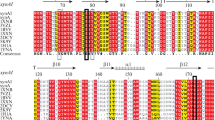Abstract
The gene xynB from Aspergillus sulphureus encoding the endo-β-1,4-xylanase was de novo synthesized by splicing overlap extension polymerase chain reaction according to Pichia pastoris protein’s codon bias. The synthetic DNA and wild-type DNA were placed under the control of a glyceraldehyde-3-phosphate dehydrogenase gene promoter (GAP) in the constitutive expression vector plasmid pGAPzαA and electrotransformed into the P. pastoris X-33 strain, respectively. The transformants screened by Zeocin were able to constitutively secrete the xylanase in YPD liquid medium. The maximum yield of the recombinant xylanase produced by the synthetic DNA was 105 U ml−1, which was about 5-fold higher than that by wild-type DNA under the flask culture at 28 °C for 3 days. The enzyme showed optimal activity at 50 °C and pH 5.0. The residual activity remained above 90% after the recombinant xylanase was pretreated in Na2HPO4–citric acid buffer (pH 2.4) for 2 h. The xylanase activity was significantly improved by Zn2+. These biochemical characteristics suggest that the recombinant xylanase has a prospective application in feed industry as an additive.







Similar content being viewed by others
References
Singh, S., Madlala, A. M., & Prior, B. A. (2003). FEMS Microbiology Reviews, 27, 3–16. doi:10.1016/S0168-6445(03)00018-4.
Polizeli, M. L. T. M., Rizzatti, A. C. S., Monti, R., Terenzi, H. F., Jorge, J. A., & Amorim, D. S. (2005). Applied Microbiology and Biotechnology, 67, 577–591. doi:10.1007/s00253-005-1904-7.
Sunna, A., & Antranikian, G. (1997). Critical Reviews in Biotechnology, 17, 39–67. doi:10.3109/07388559709146606.
Wong, K. K., Tan, L. U., & Saddler, J. N. (1988). Microbiological Reviews, 52, 305–317.
Gilkes, N. R., Henrissat, B., Kilburn, D. G., Miller, R. C., Jr., & Warren, R. A. (1991). Microbiological Reviews, 55, 303–315.
Henrissat, B., & Bairoch, A. (1993). The Biochemical Journal, 293, 781–788.
Henrissat, B., & Davies, G. (1997). Current Opinion in Structural Biology, 7, 637–644. doi:10.1016/S0959-440X(97)80072-3.
Beg, Q. K., Kapoor, M., Mahajan, L., & Hoondal, G. S. (2001). Applied Microbiology and Biotechnology, 56, 326–328. doi:10.1007/s002530100704.
Damaso, M. C. T. (2003). Applied and Environmental Microbiology, 69, 6064–6072. doi:10.1128/AEM.69.10.6064-6072.2003.
Wu, Y. B., Ravidran, V., Thomas, D. G., Birtles, M. J., & Hendricks, W. H. (2004). British Poultry Science, 45, 385–394. doi:10.1080/00071660410001730888.
Bedford, M. R., & Classen, H. L. (1992). The influence of dietary xylanase on intestinal viscosity and molecular weight distribution of carbohydrates in rye-fed broiler chicks (pp. 361–370). Elsevier: Amsterdam.
Barrera, M., Cervantes, M., Sauer, W. C., Araiza, A. B., Torrentera, N., & Cervantes, M. (2004). Journal of Animal Science, 82, 1997–2003.
Thacker, P. A., & Baas, T. C. (1996). Animal Feed Science and Technology, 63, 187–200. doi:10.1016/S0377-8401(96)01028-0.
Xia, T., & Wang, Q. (2009). World Journal of Microbiology & Biotechnology, 25, 93–100. doi:10.1007/s11274-008-9867-3.
Weng, X. Y., & Sun, J. Y. (2005). Current Microbiology, 51, 188–192. doi:10.1007/s00284-005-4543-4.
Lee, J. W., Park, J. Y., Kwon, M., & Choi, I. G. (2009). Journal of Bioscience and Bioengineering, 107, 33–37.
Wang, Y. R., Zhang, H. L., He, Y. Z., Luo, H. Y., & Yao, B. (2007). Aquaculture (Amsterdam, Netherlands), 267, 328–334. doi:10.1016/j.aquaculture.2007.03.005.
Zhou, C. Y., Li, D. F., Wu, M. C., & Wang, W. (2008). World Journal of Microbiology & Biotechnology, 24, 1393–1401. doi:10.1007/s11274-007-9622-1.
Cao, Y. H., Qiao, J. Y., Li, Y. H., & Lu, W. Q. (2007). Applied Microbiology and Biotechnology, 76, 579–585. doi:10.1007/s00253-007-0978-9.
Lu, W. Q., Li, D. F., & Wu, Y. B. (2003). Enzyme and Microbial Technology, 32, 305–311. doi:10.1016/S0141-0229(02)00292-2.
Cao, Y. H., Chen, X. L., He, P. L., & Lu, W. Q. (2006). Biotechnology Letters, 17, 858–861.
Kim, T. R., Goto, Y., Hirota, N., Dawata, K., Denton, H., Wu, S. Y., et al. (1997). Protein Engineering, 10, 1339–1345. doi:10.1093/protein/10.11.1339.
Reverter, D., Ventura, S., Villegas, V., Vendrell, J., & Avilés, F. X. (1998). The Journal of Biological Chemistry, 273, 3535–3541. doi:10.1074/jbc.273.6.3535.
Sanger, F., Nicklen, S., & Coulson, A. R. (1977). Proceedings of the National Academy of Sciences of the United States of America, 74, 5463–5467. doi:10.1073/pnas.74.12.5463.
Miller, G. L. (1959). Analytical Chemistry, 31, 426–428. doi:10.1021/ac60147a030.
Zhao, X., Huo, K. K., & Li, Y. Y. (2000). Chinese Journal of Biotechnology, 16, 308–311.
Sue, M. P., Mariana, L. F., Brian, M., & Linda, M. H. (2005). Yeast (Chichester, England), 22, 249–270. doi:10.1002/yea.1208.
Nikolay, S. O., Willem, J. S., & Maarten, A. J. (2002). Protein Expression and Purification, 24, 18–24. doi:10.1006/prep.2001.1523.
Waterham, H. R., Digan, M. E., Koutz, P. J., Lair, S. V., & Cregg, J. M. (1997). Gene, 186, 37–44. doi:10.1016/S0378-1119(96)00675-0.
Deng, P., Li, D. F., Cao, Y. H., Lu, W. Q., & Wang, C. L. (2006). Enzyme and Microbial Technology, 39, 1096–1102. doi:10.1016/j.enzmictec.2006.02.014.
Acknowledgements
This work was supported by the Program for New Century Excellent Talents in University (NCET-07-0807), the National High Technology Research and Development Program (2007AA100601), and the Project of State Key Laboratory of Animal Nutrition (2004DA125184 (team) 0806).
Author information
Authors and Affiliations
Corresponding author
Rights and permissions
About this article
Cite this article
Li, Y., Zhang, B., Chen, X. et al. Improvement of Aspergillus sulphureus Endo-β-1,4-Xylanase Expression in Pichia pastoris by Codon Optimization and Analysis of the Enzymic Characterization. Appl Biochem Biotechnol 160, 1321–1331 (2010). https://doi.org/10.1007/s12010-009-8621-0
Received:
Accepted:
Published:
Issue Date:
DOI: https://doi.org/10.1007/s12010-009-8621-0




